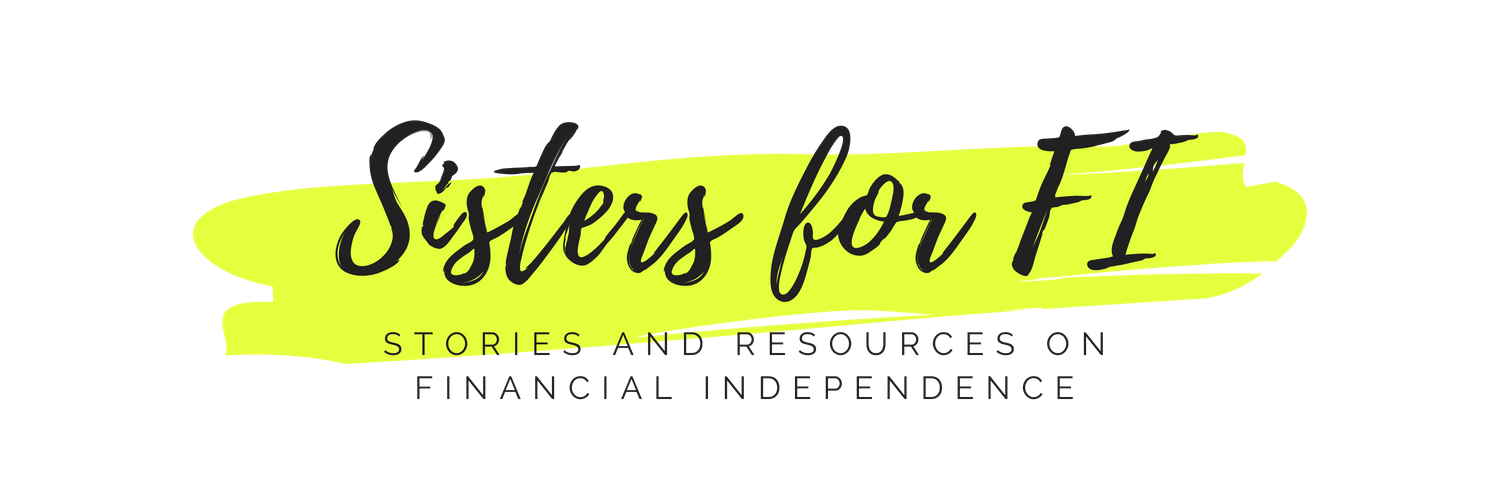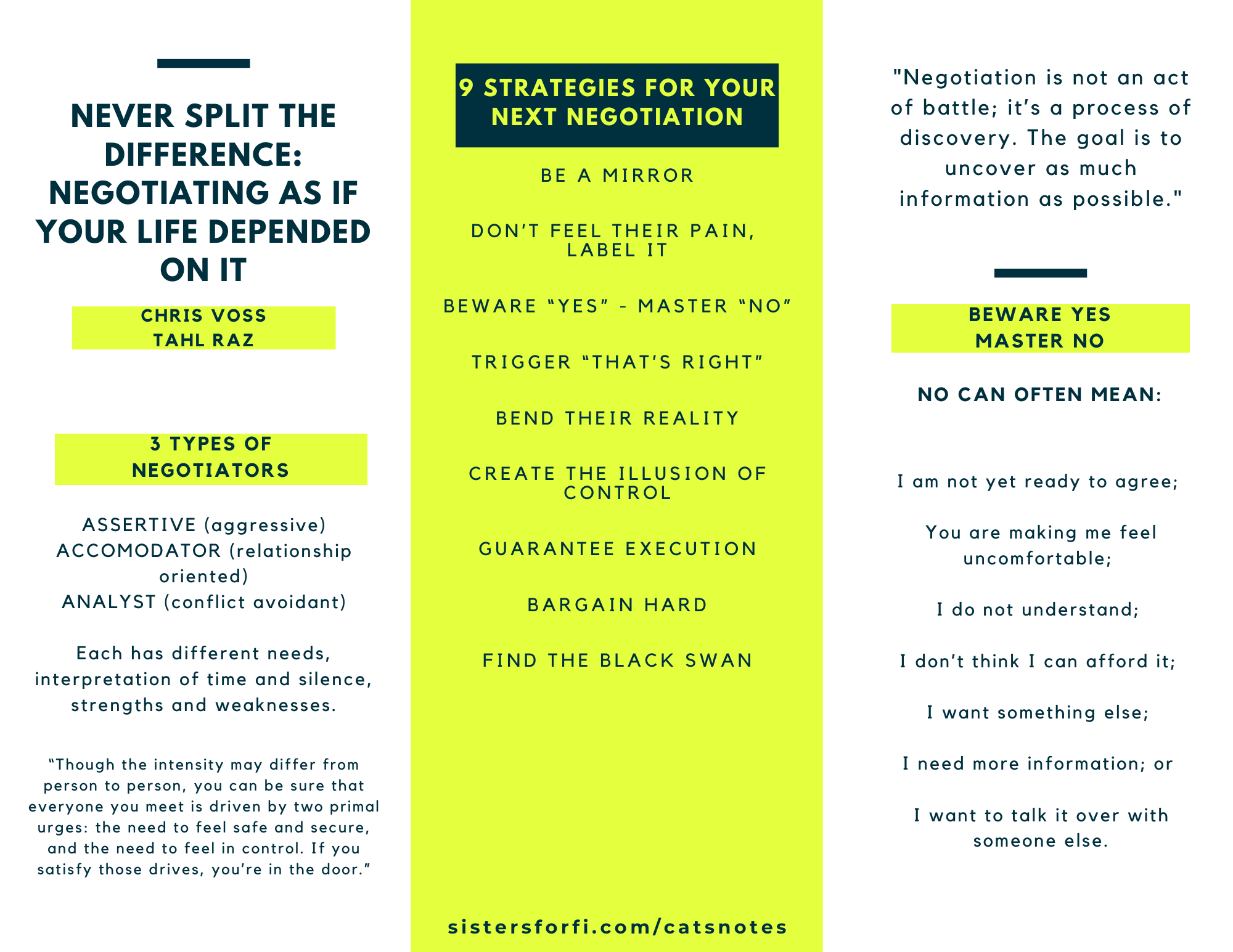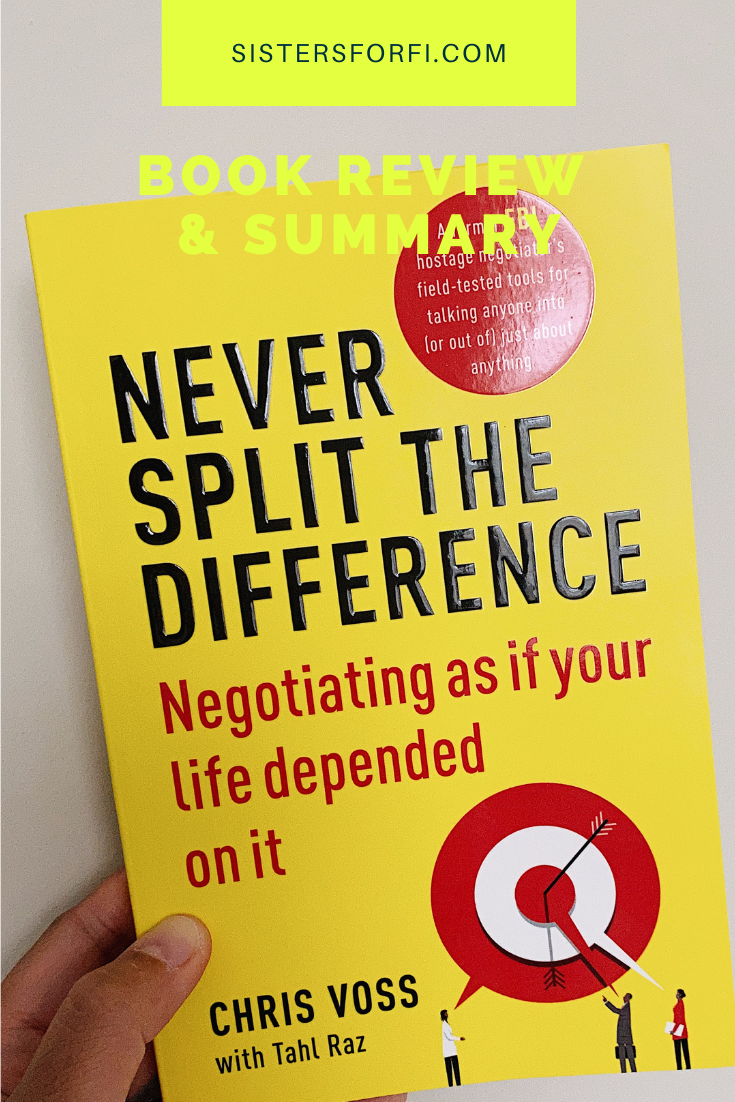Book Review and Summary: Never Split the Difference by Chris Voss
“Negotiation is not an act of battle, but a process of discovery.”
This month’s book is all about negotiations. It’s called “Never Split the Difference: Negotiating as if your life depended on it” by Chris Voss. Chris Voss is a former FBI kidnapping negotiator. He shares nine key strategies that he and his colleagues learned and use to help people in very risky situations. Here are the chapters in the book which correspond to the nine tested strategies.
Be A Mirror
Don’t Feel Their Pain, Label It
Beware “Yes” - Master “No”
Trigger the Two Words That Immediately Transform Any Negotiation
Bend Their Reality
Create the Illusion of Control
Guarantee Execution
Bargain Hard
Find the Black Swan
Know What Kind of Negotiators are at the Table
Voss explains that there are 3 types of negotiators: Analyst, Accommodator and Assertive.
It’s best to get a sense of what kind of person you are negotiating with as certain strategies will work on certain types of people.
Analysts are methodical and diligent. They normally take their time to review all of the information. They hate surprises as they pride themselves on not missing details. Silence to them is a opportunity to think so it’s important to build these in to your negotiations. Analysts can sometimes seem cold and it’s important if you are an Analyst to be a bit more open so that your counterpart will be more apt to share information.
Accomodators are sociable, peace-seeking and loves to build rapport with their counterpart. Even if nothing has actually been done, building that relationship is worthwhile for an Accomodator. An Accomodator has a tendency to first activate the reciprocity cycle and they may agree to something that can’t be delivered. Accomodators may not be so forthcoming with objections as they want to remain likable and want a deal to go through so it’s important to question an easy “Yes!” If you are Accomodator, be weary of lots of talk without actual decisions being made.
Assertives are candid and direct. They love to win and will likely do what they can in order to get a good outcome. Assertives want to be heard and this may mean they focus on their own goals without considering their counterparts. If you are an Assertive, review your tone so as not to seem unapproachable.
Based on the brief descriptions above, do you know what kind of negotiator you are?
I’m more of an Analyst and a bit of an Accomodator. This is why I like to negotiate via email because it gives me plenty of time to think, review and consider all of my options.
Book Review and Summary: Never Split the Difference by Chris Voss
The Pause
An important strategy when negotiating is to remember The Pause. The Pause is all about slowing down the negotiation process and learning to actively listen to your counterpart. Listening allows you to discover pieces of information that can help you with the negotiation. Many people rush to fill in the silence which can be a detriment because there’s a likelihood that you are too busy thinking about how to say instead of actually processing what is being said. The author shares a few examples of how pausing and using the silence can work towards your advantage.
For an Analyst, silence can be the opportunity to think and process information.
For an Assertive, silence can be the opportunity to speak more which can mean they reveal information that you can use for your own needs.
By understanding what kind of negotiator you are and what kind of negotiator your counterpart is, you can use The Pause to your advantage.
Beware “Yes” - Master “No”
This was an interesting chapter, frankly because all of our lives we fear hearing the word No. Voss instead states that “No” should be the start of the negotiation, not the end. We also need to be weary of an easy or a fast “Yes” as it almost, always leads to backtracking.
A “No” can often mean:
I am not yet ready to agree;
You are making me feel uncomfortable;
I do not understand;
I don’t think I can afford it;
I want something else;
I need more information; or
I want to talk it over with someone else
This is why he never suggests taking “No” for an answer, find another way to continue the negotiation so you arrive at a solution for both parties.
Should You Read This Book
This book provides a good amount of strategies to try and master in your next and future negotiations. While I wish the book had more examples of how to negotiate in certain situations, I think the strategies and examples listed can be very beneficial. It’s also very straightforward and easy to read. Probably one of the reasons you may want to read this book is to boost your confidence in negotiating your next salary. Tips like providing a range, negotiating for non-monetary benefits, and giving odd numbers can help you earn a bit more which helps your overall financial independence journey.
Interestingly, when I first read this book, I was a mother to a 17-month-old, I see a lot of similarities to how the Montessori Method recommends interaction and teaching with children. Young children live in the present so they feel that their needs are important now. Many parents find that they have to negotiate all the time with their toddlers. In the Montessori Method, they propose letting the child have the illusion of control by giving them choices and making sure to label emotions to help the child process what is happening.
Voss and his book state similar strategies because they’ve found that your counterparts in a negotiation can be impulsive in their wants and are also processing a lot of information and emotions during the negotiation. If you’ve been on the other side of the negotiation with a toddler, you’ve likely experience high emotions.
“Negotiate in their world. Persuasion is not about how bright or smooth or forceful you are. It’s about the other party convincing themselves that the solution you want is their own idea. So don’t beat them with logic or brute force. Ask them questions that open paths to your goals. It’s not about you.”
“Though the intensity may differ from person to person, you can be sure that everyone you meet is driven by two primal urges: the need to feel safe and secure, and the need to feel in control. If you satisfy those drives, you’re in the door.”
Negotiating as a Mother
It probably comes as no surprise that mothers are tough negotiators. In fact, for many of us, our first negotiation experiences were probably with our parents. Negotiation can sometimes get a bad rap because it looks like we aren’t listening or not being amenable to others’ needs. Now as a mother to an almost 4-year-old, I found the insight to this book even more valuable. I am constantly negotiating. My daughter is definitely an Assertive Negotiator so while I default to the Accommodator role, I now know it’s not in my best interest too.
If you are a woman reading this book or a parent unsure if you should be negotiating, I think it’s safe to say that negotiating is a good thing. We need to practice how to be good negotiators so when the time comes we are prepared and ready to get the things that we want. It’s also super critical to teach our kids how to be better negotiators and that can only come from practice. With a lot of insight from this book, I absolutely now encourage my pre-schooler to negotiate - ask for the things that she wants. Sometimes she gets it, sometimes she doesn’t, but I want her to learn that it’s Ok to ask and not take No as the end. Parent tip: Keep the list of “No” alternatives handy so that you can find the right solution without resorting to bribing or forceful will.
The appendix in the book has a lot of helpful action items to take on for your next negotiation. Being prepared will certainly boost not only your confidence in the next negotiation but will likely result in the outcome you want. So check the book out. Even if you aren’t negotiating high-value deals in the boardroom, you might find the tips in the book helpful in your day to day.
9 Field-Tested, No-Fail Strategies to Use in Your Next Negotiation
Source: blackswanltd.com
Book Review and Summary: Never Split the Difference by Chris Voss









